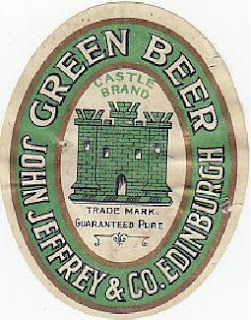Messrs Jeffrey's ale store at Roseburn consists of two floors, each open throughout, and measuring 600 feet in length by 120 feet in width. A portion of the ground floor at one end is devoted to the bottling of ales for export, which forms a considerable item in the business of the firm. The remainder of the floor is piled with five or six tiers of large store casks, in which the beer is placed to mellow until required to be bottled or otherwise disposed of. Cranes, tramways, &c, are provided for moving the casks; and in this, as in the other parts of the establishment, hand labour is reduced to a minimum. On the floor above the empty casks are kept. The bottling operations are conducted with great expedition. The bottles arrive in crates, on being taken from which they are thoroughly rinsed, placed on hand-trucks, and brought forward to the bottlers. A boy sits in front of each bottling-machine, which consists of a series of six taps arranged on the syphon principle. Beginning at the left-hand side of the machine, he places a bottle on each tap, and by the time he gets the sixth bottle attached the first is full. Removing the full bottle he replaces it by an empty one, and so on. The rapidity of his movements may be judged from the fact, that in the course of a day of ten hours he fills 12,000 bottles, which is equal to an average rate of twenty a-minute. For the service of each bottling-machine there is a corking-machine, worked by a stout lad assisted by a boy; and a staff of "wirers" and "foilers." The corking goes on at the same rate as the filling; but as the wiring is a slower process, two nimble-fingered boys are required to wire for each machine. The wiring is indispensable in the case of beer intended for export. In some cases the cork and neck of the bottle are covered with tinfoil, and in others by metallic capsules, which are attached with great expedition. When all these operations are completed, the bottles pass to the labeller, who, holding a bunch of gummed labels in one hand, applies them with the other to the bottles, which are always moist enough to make the paper adhere firmly. Thus got up, the bottles have rather a gaudy appearance. As they are subjected to the successive operations described, the bottles are passing from one side of the bottling-house to the other; and as they leave the hands of the labellers, they reach the packers. One set of men in this department twist a layer of straw round each bottle, and another set pack the bottles into dryware barrels which contain two or four dozen each. When the barrels are filled, they are taken charge of by coopers, who put in the heads and make all secure. The barrels are then rolled across the yard to a steam-hoist, by which they are elevated to a platform on the railway siding belonging to the works, and thence taken to the port of shipment. Adjoining the stores is the cooperage, which is on a scale commensurate with the other departments of the establishment . The beer-casks are made of seasoned oak, which is cut up and shaped by steam-machines. The old system of firing has been abolished, and after the staves are "set up,"—that is, arranged in a circular form within a strong iron hoop,—they are placed under a hollow iron cone, and subjected to the action of steam, which speedily makes them pliable ; and while in that condition, they are "trussed" into form. Making large casks is heavy work. The dryware barrels are of slighter construction and are hooped with wood. Of these an immense number are turned out weekly.There's some great information in there. Firstly that they were exporting bottled beer. The 1860's is quite early for that. The bottles were put in dryware barrels (not as sturdy as ones intended for liquids) and packed with straw.
Notwithstanding the numerous mechanical appliances which exist in the various departments of Messrs Jeffrey's establishments, they require the services of 250 men.
"The industries of Scotland: their rise, progress, and present condition" by David Bremner, 1869, pages 441 - 443.
Secondly beer was being matured in casks. Large casks, but not vats. That's an important difference. The days of large immovable vats, as used for Porter brewing, were almost a thing of the past. Whitbread stopped brewing their Keeping Porter in the 1870's. By 1900, few beers were vatted. Mostly very strong Stouts and Stock Ales.
"hand labour is reduced to a minimum". It doesn't sound like that from the description. Not with all those boys hand-filling, corking, wiring, foiling, labelling and wrapping in straw. It's a far cry from a modern, fully-automated bottling line.











































































3 comments:
An interesting extract, showing the great care and relative sophistication of packaging operations of the day. The part about placing tinfoil around the necks shows that the practice must have started around this time.
Some "of a certain age" will remember that "premium" bottled beers often had this appendage, often tapered or angle-cut, e.g. I remember many German brands did. It was something you often saw on German, French and some American bottles (but not always, e.g. Heineken never used it I think). Lowenbrau used it if memory serves again.
Today the flourish looks (to me) old-fashioned but you still see this vestige of late-1800's posh packaging here and there.
Gary
I think I have Taunton ale being shipped to the West Indies in bottles from Bristol in the 1730s: http://beerblog.genx40.com/archive/2010/june/firsttherewas#comment190964
Sounds disturbingly familiar to me, though we have a Polish part-timer to do most of the hard labour.
Post a Comment